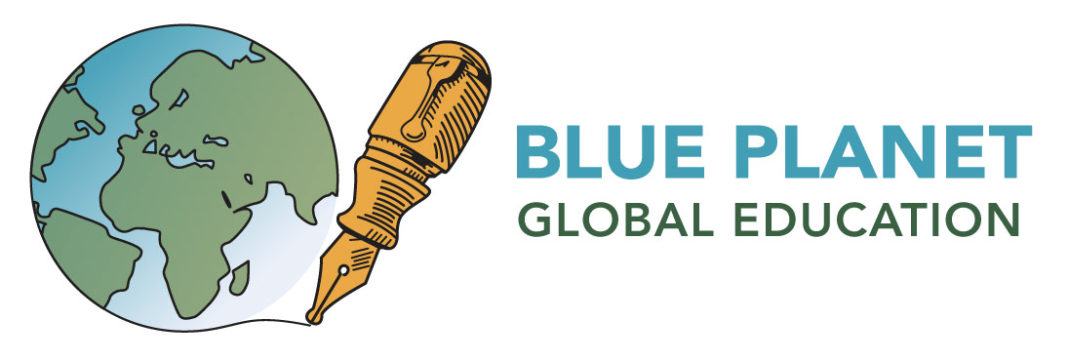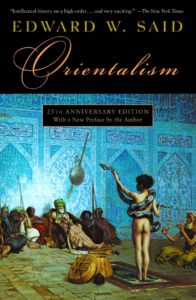I’ve been thinking about Orientalism, Edward Said’s foundational 1978 text on how the West (what Said refers to in his historical moment as the Occident) has traditionally viewed the East (Asia, the Middle East, and Northern Africa, or “the Orient”). Said defines Orientalism as “a way of coming to terms with the Orient that is based on the Orient’s special place in European experience” (p. 1). In other words, an Orientalist perspective defines the West–by juxtaposing it with what it is not–as much as it purports to define the East.
This viewpoint doesn’t just define the East, though–it provides a foundation, a set of reasons and rationalizations, for the West to intervene in and dominate the East. It creates an unequal power structure, and it justifies this imbalance because of the negative profile it assigns the East.
Reading about the ways in which Europe and the US have defined and dealt with the other half of the world has left me, naturally, with some thoughts and questions that are especially relevant to the project of connecting students across borders through the device of first-person narratives.
Because of my own work, the moments in the book that most resonated for me were those that looked at the power structure of those-who-speak and those-who-are-spoken-for. In one especially important passage, Said argues that “in discussions of the Orient, the Orient is all absence, whereas one feels the Orientalist [the Westerner who studies the Orient] and what he says as presence” (p. 208; emphasis mine).
How does the Orient become absent? How does it disappear even as the Western scholar–or novelist or travel writer, even–is attempting to represent it? Said explains the process like this:
First, the West defines the Orient as the opposite of itself, as the Other. Four defining “dogmas” are established:
- The West is rational, developed, humane, superior; the Orient is irrational, undeveloped, and inferior.
- Abstract statements about the Orient, especially those that refer to a “classical” Orient of ancient times, are always preferable to present-day evidence we can see with our own eyes.
- The Orient is eternal, uniform, and–very important–incapable of defining itself; thus, Western writers must use a highly generalized and systematic vocabulary to describe it.
- The Orient is, at bottom, something either to be feared or controlled. (pp. 300-301)
These dogmas enable the West to establish the Orient–and all its many countries, cultures, and people–as an inferior, incapable bloc, a monolithic, homogenous region rather than a collection of diverse individuals.
And because the West perceives the Orient as incapable of speaking for itself, the West must speak for it. The West, Said contends, believes that it knows things about the Orient that the Orient, because of its primitive and backward nature, doesn’t even know about itself (p. 300). The West begins to deal with the Orient as a set of problems rather than people.
Let’s review quickly: how does the West know it’s superior to the Orient?
Well, it says so right in the dogmas.
The dogmas established by the West.
This is a tautology, of course–it’s circular reasoning. But because the West, in the past few centuries, has been home to the dominant military and financial powers in the world, it has gotten to say pretty much what it wanted about non-Western countries. Might lets you write the stories.
Thus, beginning in the 19th century, that era of European exploration and expansion into the Orient, practically everything people in the West “knew” about the Orient had been reported, written about, and filtered through the Western gaze and the position of Western privilege.
Let’s bring Carl Jung into the discussion for a moment now. Jung said, “The reason for evil in the world is that people are not able to tell their stories.”
This statement speaks directly to this process by which the West presumes to tell the stories of Eastern people, rather than inviting them to speak for themselves. They are consigned to hearing themselves described as uncivilized, as irrational, as exotic, as outside of what is “normal.”
Perhaps, after a while, they even begin to believe the descriptions. I’m thinking of the heartbreaking moment in The Souls of Black Folks when W.E.B. Du Bois says, of African-Americans exhausted by the ways in which they have been represented by whites,
“Suppose, after all, the World is right and we are less than men?”
And so, the importance of first-person narrative becomes apparent. The importance of enabling people to speak for themselves rather than assuming the power to speak for them. Said himself extolled the power of narrative in countering the unchanging “encyclopedic or lexicographical vision” of the Orientalists toward their objects of study:
“Narrative,” he wrote, “asserts the power of men to be born, develop, and die, the tendency of institutions and actualities to change, the likelihood that modernity and contemporaneity will finally overtake ‘classical’ civilizations; above all, it asserts that the domination of reality by vision is no more than a will to power….”
He continues: “Narrative, in short, introduces an opposing point of view, perspective, consciousness to the unitary web of vision; it violates the serene Apollonian fictions asserted by vision.” (p. 240)
Narrative–especially first-person narrative–then, is key to learning about other people who live in other places, in other cultures. When students can learn about another part of the world through the stories shared by its inhabitants–and when they can teach about their own corner of the globe by sharing their own stories–everyone gets the chance to speak. No one is absent, no one is speaking for anyone else. Pre-constructed visions of the Other can be interrogated and refuted; reality can shine through.
Everyone gets a seat at the storytelling table. Everyone gets to share their own experience of what it is to be Chinese, or Swedish, or Ugandan…or American.
First-person narratives, shared across borders, can contribute to the questioning of pre-existing assumptions on all sides, about all sides. These stories are little nuggets of truth, in the sense that we all have our own truth, we all have our own experience of living in a particular country or culture at a particular moment, we all have knowledge to share. Rather than reading about another part of the world through a Western–or even Eastern–filter (constructed visions of the United States certainly exist, as we all know) or through a media-constructed narrative, or through government-sponsored propaganda, students can read the stories of actual human beings, written by the human beings themselves. Occident and Orient, Us and Them, become categories that are not quite as relevant when we realize that the Other is not monolithic, not homogenous. That countries and cultures are made up of people, so different from each other and yet sharing so many characteristics, as well.
So to end this post on using stories to dismantle Orientalism, you might listen to Leonardo by the Turkish artist Oceanvs Orientalis, otherwise known as Safak Oz Kutle. “My musical influences,” Kutle says in an interview with Ibiza Voice, “come from many different stories of man and nature.” A splendid source of inspiration.

